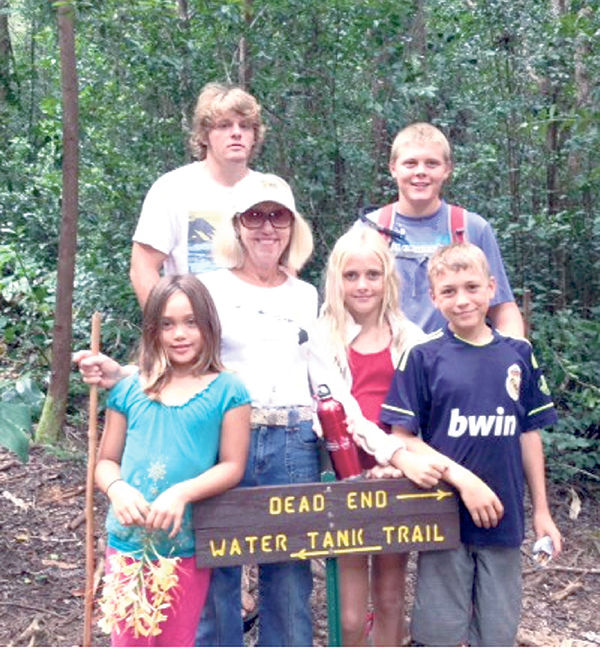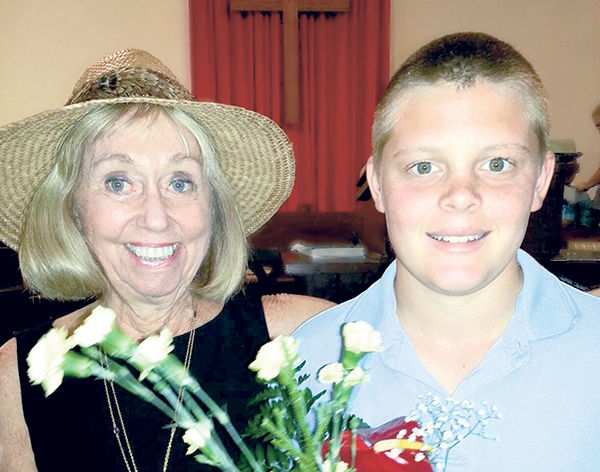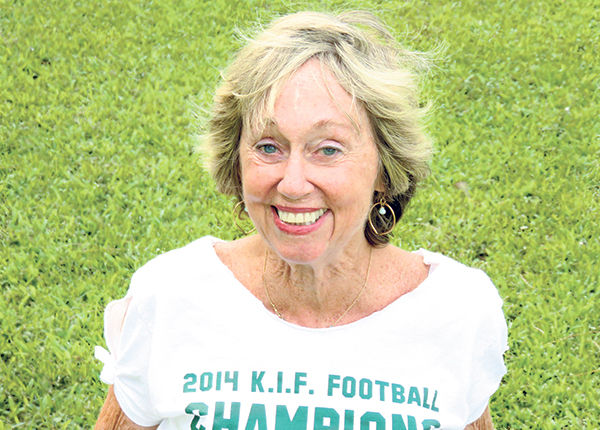Lost and found in Kokee
The last thing Pam Dohrman anticipated when planning to celebrate Mother’s Day with her family in Kokee State Park was that she would get so lost on a simple afternoon hike, she would spend two nights sleeping alone in the wilderness before being rescued.
It was the afternoon before Mother’s Day, May 2013. Pam’s family was gathering for a big dinner in Kokee, the lush rain forest located at 4,000 feet elevation in the northwest region of the Garden Island.
By the time she arrived at the family’s mountain cabin, Pam’s children and grandchildren were out on a hike on one of Kokee’s many trails. A fit and active 72-year-old, Pam decided to take a little walk of her own. Having grown up on Kauai, she had hiked in Kokee many, many times. She tossed two apples, some water and a lightweight jacket in her backpack and set off.
After hiking about 45 minutes, she came across the sign with arrows pointing which direction to go for both the long and short versions of the trail. Not realizing the sign had been turned, Pam followed the arrow for the longer path — and was soon off the official trail and on her way into the dense thicket.
Only after her rescue did Pam learn that junction has often been called the Bermuda Triangle because of the number of hikers and hunters who have gotten lost there in years past.
‘Of course I’ll find my way’
Within half an hour, Pam found herself in a thick forest of trees and realized she was not on the normal trail. She tried to retrace her steps, but she could not find her way back.
“I was just on the trail taking a walk. How could I be lost already?” she asked herself. “It was about 4:30 in the afternoon. I wasn’t worried. I thought, ‘Of course I’ll find my way.’”
As she hiked, she came across an eerie homesite in the brush with a tarpaulin, discarded batteries and other miscellaneous rubbish. There were spikes in a nearby tall tree to allow the resident to climb up and detect intruders.
“The place had bad vibes,” Pam recalls. “Whether the guy was growing dope or whatever, it felt like a bad place. I said, ‘I’ve got to get out of this spot.’”
She walked and walked, trying to find her way back to the trail — but an hour later, she found herself back at the creepy tent again.
“I came back to that bloody place!” she says. “I had read and have heard many times since, that when you’re lost, every time you’ll make a circle. True!”
Undaunted, she struck out once more.
“I went bound and determined that that would not happen again — and it did. Second time!” she says. “Now it’s 6:30, getting kind of late and it will get dark soon. I just went, ‘I’m 100 percent lost. I don’t know which way to go at all.’”
When Pam left the spooky shanty again, it was 7 p.m. and almost dark.
“I wasn’t scared but I started to worry about my kids because I knew they’d get scared as it started to get dark,” she says. “I went, ‘Oh jeez, I have blown Mother’s Day.’
“I became very matter-of-fact with myself. I said, ‘I now need to think about spending the night somewhere because there’s nothing more I can do tonight.’”
True to her practical nature, honed by her career as a nurse, Pam set about looking for a safe place to stay. She found a flat spot with lots of leaves on the ground, sheltered by some tall trees.
She was completely out of her drinking water and had eaten both apples. Her mobile phone battery had died, and in the mountains of Kokee, she wouldn’t have had reception, anyway. She is completely deaf in one ear and the battery in her hearing aid in her other ear was dead.
‘Now I’m going to findthe way out’
Settling in for her first night on the forest floor, Pam made the most of her situation: “Out came the stars. Beautiful night!”
She willed herself to sleep so she would be rested for the new day, wrapping herself in her thin pink jacket. Though she woke a couple times, feeling very cold, she surprised herself by mostly sleeping through the night.
First thing in the morning, “I got up and I said, ‘OK, it’s a new day. Now I’m going to find the way out.’”
But thoughts of her children flooded her mind.
“I was sick with worry for my kids,” she says. “Now I know they’re out searching for me.”
Pam walked and walked, once finding herself at the edge of a cliff. Eventually she spotted a patch of light coming through the dense forest and walked toward it, finding a raised area of ground that formed a platform filled with uluhe fern.
“I thought, ‘If I get higher, maybe somebody will see me, because I’ll be out of this dense, dark forest where nobody can see me,’” she said.
By now, Pam was dehydrated and could no longer stand up. She knew she needed to stay out of the sun to prevent further dehydration, so she dragged herself across the uluhe, which was sticky and poking her, until she was atop the platform under the shade of trees.
“It wasn’t far from where I’d spent the night, but that’s as far as I could go,” she said.
About 9 a.m., she saw a red helicopter fly by in the distance. “Don’t tell me the kids called a helicopter! Oh dear. How embarrassing,” she said to herself.
But the pilot apparently didn’t see her and the helicopter disappeared into the fog.
“I was dying for my kids because I knew they were suffering and I knew I was OK,” she says. “I felt that they were probably looking in ravines, but I was sort of on a high spot on this platform. I kept saying, ‘Look up! Look up!’ Then I started to think about dying and what that would be like,” she says.
She recalled a recent conversation with a man about Buddhism.
“He told me, ‘Buddha says, In the end there are three things: How well you lived, how well you loved and how well you let go.’
“On that day I thought, well, it’s about 50-50: I might be rescued; I might die. So Jesus, it’s time for a talk. I said, ‘I’m having a real, real hard time with the letting go. I don’t want to let go of my kids, my grandkids. I’m just not ready yet.’ I asked Jesus to cradle my kids in their arms and take care of them.”
‘Life will never be the same’
As nightfall came, Pam willed herself to sleep again, her second night sleeping in the wild with only her thin jacket as bedding. She awoke numerous times during the night, shaking with cold.
The next morning she was very thirsty, and tried catching rainwater in her water bottle to little avail. She also tried capturing drops of water from leaves of plants, transferring them to her fingernail, but that was great effort for almost no gain.
In spite of her dehydration, she felt reasonably well.
“I had lots of energy, I just couldn’t stand up,” she says. “I had all my wits. Sheer determination, I think. I wasn’t cuckoo.”
She mentally began readying herself for another long day — when suddenly, she heard voices.
“The voices got closer and louder! Then I heard, ‘Is it Pam?’ I actually jumped up and hollered, ‘Yes, it’s Pam!’ with all my might. I looked down from the platform where I had slept and I see these two eyes, a young man about 20 years old. I tumbled down through the blackberry vines and just grabbed onto him. I was so happy, so happy!
“We got up to the road and there was my son, David, and a search party of familiar faces,” Pam said. “It was heaven from then on.”
About 100 friends and family had been searching for Pam for two days, but her rescuer, Kekoa Augustin, hadn’t heard anything about the effort before asking his uncle, Bully Mission, head of the search for the Department of Land and Natural Resources, why there were so many people swarming around Kokee that day. Bully explained, and Kekoa and friends instantly volunteered to join the search. Twenty minutes later, they found Pam.
Ten days after her rescue, Pam returned to Kokee to hike and to get pono, or right, with the area.
“I’m not going to scaredy cat. I love it up there,” she says.
Now she always tells someone which trail she is going to hike, as her family had no idea which trail she had chosen that Mother’s Day eve.
“Life will never be the same. I am grateful every single day, every part of every day,” Pam says, smiling. “I got my life back.”
•••
Pamela Varma Brown is the publisher of “Kauai Stories” and the forthcoming “Kauai Stories 2.”




